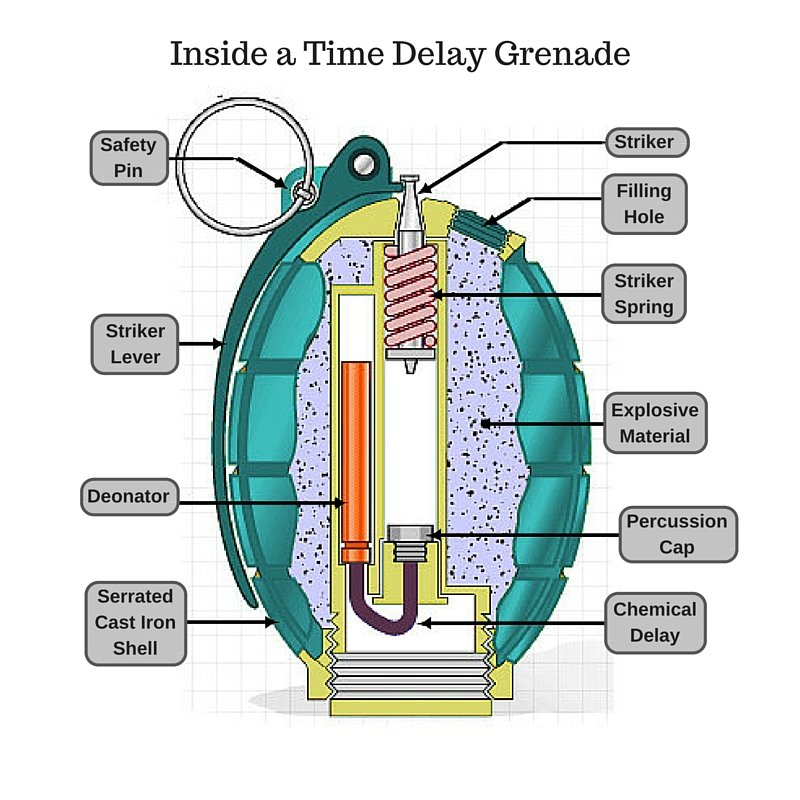Table of Contents (click to expand)
No, being underwater will not save you from a grenade explosion. The explosion will cause the same damage to your body whether you are on land or underwater.
The whole premise of this debate revolves around the fact that some day, you might have to survive a grenade explosion, and the only thing you can choose between is diving underwater or trying your luck on land. Chances of that happening are pretty low, unless you work with the military or you’re a coyote trying to kill the roadrunner. However, some information might help someone who’s curious about which choice would be wiser. If you have a grenade explode 5 feet away from you, should you be underwater or on land?

Grenades are powerful explosives that shouldn’t be toyed with, so please note that grenades are deadly when used without proper training or supervision. Therefore, you should probably learn something about grenades so that you fully understand the physics involved and are better equipped to deal with such a dangerous situation.

Originally, grenades were simple shells filled with small spheres and gunpowder. The outer shell of the grenade, made of serrated cast iron, holds a chemical fuse mechanism, which is surrounded by a reservoir of explosive material. Grenades have been improved and upgraded over time to be more reliable and to cause more damage.
How Does A Grenade Work?
The most common type of grenade on the battlefield is a ‘time-delay fragmentation anti-personnel hand grenade’. We’ll go through every feature of this particular type of grenade one at a time. Military-grade grenades are normally ergonomically designed to fit perfectly in our palms. Most of them involve a trigger system to light the fuse, which ultimately causes the explosion. The only thing that the user needs to do to cause the explosion is pull out the pin out from the grenade and throw it.

The main function of the pin is to hold a spring-loaded lever in position. As long as you haven’t released the spring lever, you can reinsert the pin and save the grenade for another time. The spring lever, on the other hand, holds a striker inside the grenade, rendering it immovable when not in use. When the pin is removed by the user, the spring lever detaches itself automatically from the grenade, releasing the striker from its position. In turn, the striker free falls towards a percussion cap at the bottom, causing a small spark. The energy from this spark is used to light a fuse that leads all the way to the explosive material.  Time-delay grenades are very effective, but they also have some significant disadvantages. One problem is their unpredictability. In some chemical fuses, the delay time may vary from two to six seconds. The explosion ignites the explosive material around the sides of the grenade, creating a much larger explosion that blows the grenade apart. The grenade wall then separates into several smaller pieces along the weaker edges, turning them into multiple pieces of shrapnel moving in all directions. This is the main reason why the grenade’s exterior is waffle-shaped and why grenade explosions cause such a large blowout.
Time-delay grenades are very effective, but they also have some significant disadvantages. One problem is their unpredictability. In some chemical fuses, the delay time may vary from two to six seconds. The explosion ignites the explosive material around the sides of the grenade, creating a much larger explosion that blows the grenade apart. The grenade wall then separates into several smaller pieces along the weaker edges, turning them into multiple pieces of shrapnel moving in all directions. This is the main reason why the grenade’s exterior is waffle-shaped and why grenade explosions cause such a large blowout.

Now that we know what happens inside the grenade, let’s see how the explosion affects the environment around it.
Also Read: Can A Grenade Explode If Shot With A Gun?
What’s Safer?
For the sake of comparison, imagine the target being two human beings standing 5 meters away from two grenades that are about to explode – one underwater and one on land.
On land, when the explosion occurs, the metal shells that are projected outwards will be the most dangerous aspect. Even if a single shell makes contact, the results could be fatal. Since there is much less drag force in air than in water, the shell would feel almost no resistance as the pieces fly towards the target. The only option for the target in this scenario is to decrease the exposed body surface to a minimum. This can be done by lying face down with your feet turned towards the explosion. At a distance of 5 meters, using a standard grenade, this position gives the target a whopping 99% chance of dodging a shell hit.
However, for a target who is underwater, the chances of dodging a shell hit are 100%, because the drag force in water is so high that the shells would disintegrate due to friction before they could travel the 5 meters. However, their shells are not the only reason why grenades are so deadly. The determining factor is the explosion shockwave, and the impact that the shockwave has on a target depends on the medium.

The main difference between water and air is that air is a gas, which is infinitely more compressible than liquid water. This makes the transfer of momentum underwater much easier as compared to air. Due to the compressible nature of air, the force from the explosion is used up in compressing the subsequent layers of gas, which absorb most of the impact.
Water, on the other hand, completely transfers all of the momentum from the explosion to the target. This force would be harmless, if it wasn’t for the fact that the human body is filled with pockets of air. If our body was composed of 100% water with no hollow air-filled regions, such as our lungs, we would probably survive a grenade as the force from the explosion would be transferred through our bodies. Instead, when the explosion occurs, the shockwave compresses the air inside our bodies in a brutal manner, completely destroying our lungs. The parts of the body that are void of air, like the arms and legs, would remain unscathed.

So, there you have it. If you ever have to survive a grenade explosion, hope to God that you won’t have to do it underwater!
Also Read: Can Being Underwater Protect You From Bullets?
How well do you understand the article above!

